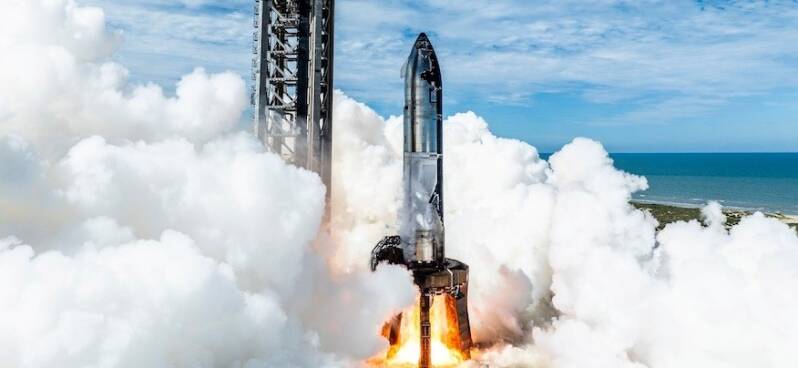SpaceX is once again preparing to send its towering Starship rocket skyward from southern Texas, with the company announcing on Friday that the vehicle’s tenth integrated test flight could take place as soon as Sunday, August 24. Liftoff from the company’s Starbase facility near Boca Chica is tentatively scheduled within a one-hour launch window opening at 6:30 p.m. CDT (7:30 p.m. EDT / 2330 UTC).

SpaceX’s Ship 37 performed a static fire test with all six of its Raptor engines as part of prelaunch testing ahead of the Flight 10 mission for the Starship program. Credit: SpaceX
The flight comes three months after the previous mission was cut short by technical problems and two months after a dramatic ground test explosion destroyed the upper stage that had originally been slated for this attempt. For this test, SpaceX will field a new pairing: Ship 37 as the upper stage and Booster 16 for the Super Heavy first stage.
According to SpaceX, the mission will focus on expanding the Super Heavy booster’s operating envelope, including multiple landing burn tests aimed at refining the rocket’s recovery profile. The company also intends to demonstrate Starship’s first payload deployment and conduct reentry experiments designed to eventually enable the vehicle’s return to the launch site for a “catch” attempt.
The payload itself consists of eight flat objects known as Starlink simulators, standing in for the next generation of Starlink satellites. SpaceX will also attempt to relight a Raptor engine during the coast phase, a milestone it has yet to achieve after several unsuccessful tries on recent flights.
Lessons From Flight 9
The upcoming mission follows a troubled predecessor. Flight 9, launched on May 27, saw Starship reach orbit but fail to complete several key objectives. Engineers later determined the ship—designated Ship 35—was lost due to a failure in its fuel tank pressurization diffuser, a component that regulates the flow of warm gases inside the methane tank.
Telemetry showed methane building up in the nosecone, which eventually caused pressure imbalances that prevented the payload bay door from opening and derailed the deployment of Starlink simulators. The vehicle ultimately lost control, vented its remaining propellant, and burned up during reentry over the Indian Ocean.
Compounding the setbacks, a month later Ship 36 exploded without warning during a fueling test at SpaceX’s Massey facility, traced to hidden damage inside a composite overwrapped pressure vessel (COPV) in the payload bay. In response, SpaceX tightened inspection protocols, reduced COPV operating pressures, and added protective covers to improve reliability.
Testing the Block 2 Starship
Ship 37 represents a fresh start. It is the latest Block 2 variant of Starship, a version designed to test new features such as upgraded heat shield tiles—some with experimental active cooling—and reinforced fittings for the dramatic “catch” maneuver SpaceX eventually hopes to attempt with the vehicle. Previous Block 2 missions (Flights 7–9) all ended in failure before these systems could be fully evaluated.
SpaceX says Flight 10’s reentry will deliberately push the ship’s structural limits, stressing its flaps at maximum aerodynamic pressure. If successful, it will mark the first time a Block 2 Starship survives controlled reentry.
While much attention is focused on Starship’s upper stage, the Super Heavy booster has faced its own hurdles. On Flight 9, Booster 14 executed a successful flip maneuver—a first—but failed during its landing burn after structural loads exceeded the strength of its fuel transfer tube, triggering an explosion.
For Flight 10, Booster 16 will again target a water landing in the Gulf of Mexico. The company plans to test a new three-engine landing sequence, transitioning mid-burn to a hover using only two engines before splashdown. Data from this maneuver will inform future recovery and reuse strategies.
Bigger Picture: NASA’s Artemis Deadlines
The high-stakes nature of these test flights goes far beyond SpaceX’s commercial ambitions. The company’s Starship system has been selected as the lunar lander for NASA’s Artemis 3 mission, which aims to return astronauts to the Moon by mid-2027. A critical step toward that goal is demonstrating cryogenic propellant transfer in orbit—a milestone NASA originally expected by 2025 but now anticipates slipping into Fiscal Year 2026.
NASA officials have voiced both concern and confidence. Lori Glaze, acting associate administrator for NASA’s exploration programs, admitted last month that the cryogenic transfer milestone is slipping, but stressed it remains the key event “everyone is watching for.” Acting NASA Administrator Sean Duffy, however, struck a more optimistic note, saying SpaceX has a proven history of learning from failures before rapid breakthroughs.
“They feel very comfortable on Starship, they feel like they’re on pace with the lander, on track, so they feel very good,” Duffy said in late July. “They said if there’s a holdup for Artemis 3, it’s not going to be them.”
If Starship completes its objectives on Flight 10, it would mark a major step forward for SpaceX after a string of setbacks, clearing the way for more ambitious missions and closer alignment with NASA’s timelines. But if the flight ends in failure, the ripple effects could push back not just SpaceX’s commercial aspirations, but also America’s goal of returning astronauts to the Moon for the first time since Apollo 17 in 1972.
For now, all eyes turn to Sunday evening at Starbase, where the world’s most powerful rocket is once again set to test the limits of engineering, perseverance, and ambition.


Add comment
Comments